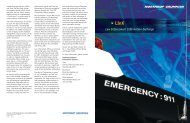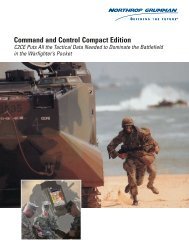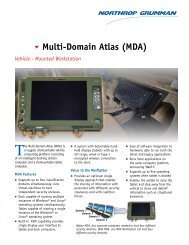Pythagoras: A New Agent-based Simulation System - Northrop ...
Pythagoras: A New Agent-based Simulation System - Northrop ...
Pythagoras: A New Agent-based Simulation System - Northrop ...
You also want an ePaper? Increase the reach of your titles
YUMPU automatically turns print PDFs into web optimized ePapers that Google loves.
Behavior-Change Triggers<br />
<strong>Pythagoras</strong>: A <strong>New</strong> <strong>Agent</strong>-<strong>based</strong> <strong>Simulation</strong> <strong>System</strong><br />
The final feature of <strong>Pythagoras</strong> that is used to represent behavior is the behavior-change<br />
event/action, or trigger. When an agent experiences one of the events/actions listed in<br />
Table 3, the current behavior template is replaced by a new one, defined by new movement<br />
and shooting desires, new color-change values, and a new set of behavior-change<br />
triggers. For example, an agent can be set to walk up and down a street, as if on patrol,<br />
but when the agent is shot at, his behavior changes to look for protective terrain, such as<br />
a doorway.<br />
To enhance behavior-change triggers, the user can decide how they will be applied.<br />
A trigger can affect either an individual agent or a user-defined group of agents, or it<br />
may cause an agent to order subordinates to change their behavior (for example, “Sound<br />
the charge!”). For that purpose, leadership can be defined as either charismatic or<br />
hierarchical:<br />
• Under charismatic leadership, agents follow the highest or strongest leader.<br />
• Under hierarchical leadership, agents follow the lowest ranking leader whom they<br />
consider to be their leader (troops follow the sergeant, who follows the major, who<br />
follows the general). Thus, orders can ripple through a group of agents, much as<br />
they would in a military organization.<br />
As usual in <strong>Pythagoras</strong>, the behavior-change threshold values are governed by soft rules,<br />
so some agents will be more resistant to change. In addition, an agent can be assigned an<br />
obedience value that determines, at random, whether the agent will accept or reject an<br />
ordered behavior-change event/action.<br />
Because the behavior template for an agent includes new triggers, and each template<br />
is uniquely named, a series of templates can be constructed to represent a complex<br />
behavior tree or network, with agents moving from one behavior to another as a scenario<br />
Table 3. Currently implemented behavior-change triggers<br />
Events/actions that cause agent to change behavior include<br />
– Being shot at<br />
– Detecting enemy<br />
– Detecting friend<br />
– Arriving at way point or objective<br />
– Suffering friendly casualties (fewer than x%<br />
known remaining)<br />
– Losing leader (no leader within d)<br />
– Red, green, or blue becoming greater or less than c<br />
– Absolute time step<br />
– Relative time step<br />
Trigger reads new, complete, explicitly named behavior template (including setting<br />
new triggers)<br />
Delay before behavior takes effect (future capability), which simulates communication/<br />
spinup time<br />
x = Force strength<br />
d = Distance<br />
c = Color value<br />
Technology Review Journal • Spring/Summer 2003 51






